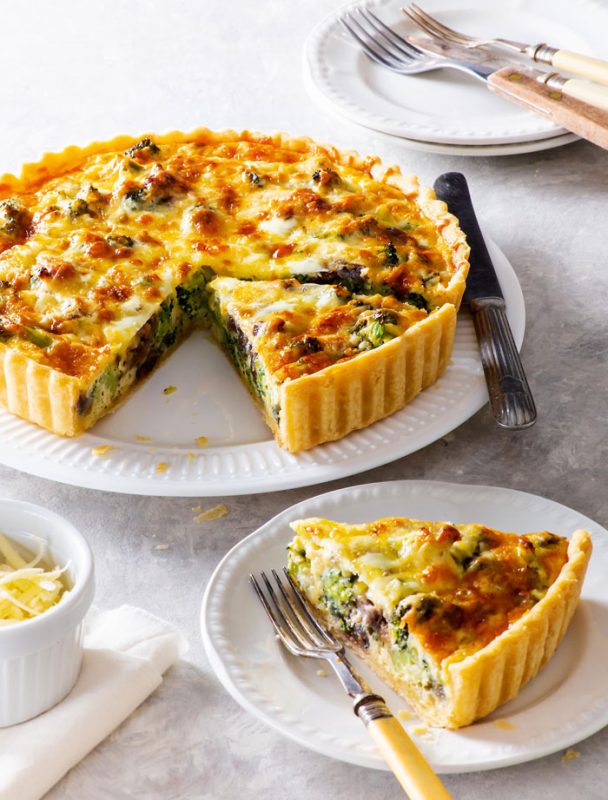There are many delicious components to this vegetarian broccoli quiche from Katarina Cermelj’ at The Loopy Whisk’s new book ‘Baked to Perfection’, but what really makes it sing are the caramelised onions. Their sweet flavour melds beautifully with the cheesy filling. The pie crust is perfectly flaky, and the broccoli is tender, with the slightest bite to it.
Recipe taken from Baked to Perfection by Katarina Cermelj (£22, Bloomsbury)
Photography © Katarina Cermelj

Caramalised onion and broccoli quiche
The pie crust is perfectly flaky, and the broccoli is tender, with the slightest bite to it.
Ingredients
For the flaky all-butter pastry
- 375 g gluten-free flour blend
- 1 tsp caster sugar
- 1½ tsp xanthan gum
- ½ tsp salt
- 250 g unsalted butter cut into 1cm cubes, chilled
- 150 g cold water
For the quiche
- ½ quantity savoury flaky all-butter pie crust
- 3 tbsp olive oil
- 3 red onions thinly sliced
- 1 broccoli head cut into bite-sized florets (about 250g prepared weight)
- 100g cheddar cheese
- 6 free-range eggs at room temperature
- 120 g whole milk at room temperature
- salt and freshly ground black pepper
Instructions
For the pastry
-
In a large bowl, mix together the gluten-free flour blend, sugar, xanthan gum and salt.
-
Add the cold butter and toss it in the flour until each piece is coated.
-
Squish each cube of butter between your fingers to form small, thin sheets of butter. Be sure to check you’ve squished all the butter pieces before adding the water.
-
Add the cold water and mix well with a fork or spatula until the dough starts coming together. After you’ve added all the water, the dough will still look very dry – don’t be tempted to add more.
-
Gently squeeze and knead the dough, pressing it against the sides of the bowl, until it comes together in a shaggy ball with little-to-no dry patches (this can take up to 5 minutes). ➁ If absolutely necessary, and if after 5 minutes the dough still hasn’t come together, sprinkle a tiny amount of water on the most persistent dry patches.
-
Shape the dough into a disc, wrap it in cling film and refrigerate it for about 30 minutes or until it feels firm but not hard when you press down on it with your finger.
-
Roll out the chilled dough on a lightly floured surface to a 15 x 45cm rectangle. Turn the dough so that a short end is closest to you. Brush off any excess flour and fold the dough as you would an A4 letter – bottom third up towards the middle and the top third down over it.
-
Turn the dough by 90 degrees (so that the open ends are closest and farthest from you). Roll out into a similar-sized rectangle and repeat the letter fold. For the best results, complete a total of 4–6 letter folds (the more you do, the greater the flakiness). If the dough becomes too soft at any point, chill it in the fridge for 15–30 minutes, then continue.
-
Wrap the dough in clingfilm and chill it for at least 30 minutes or until needed. (If you chill it for longer than 1 hour before using, soften it for about 15–30 minutes at room temperature, so that it’s pliable.)
-
STORAGE: 1 week in the fridge; 2–3 weeks in the freezer. Allow the pastry to thaw at room temperature for at least 1 hour before using – if you press down on it with a finger, you should leave an indentation (but it should feel fairly firm, not too soft to the touch).
For the quiche
-
You’ll need a 23cm loose-bottomed, fluted tart tin (about 3.5cm deep). Remove the pie crust from the fridge or freezer to come up to room temperature to prevent cracking.
-
Pressing the pastry into the grooves of the tart tin is a small detail, but that extra few minutes’ work gives a much more polished finish to the baked quiche.
-
The filling can sometimes puff up significantly during baking because of the large number of eggs, but it always levels out into a beautifully flat quiche after cooling for about 5–10 minutes.
-
Heat 2 tablespoons of the oil in a saucepan over a medium heat. Add the onions, season with salt and pepper and cook for 10–15 minutes until soft and caramelised. Transfer to a plate and cool until needed.
-
Add the remaining oil to the hot pan, then add the broccoli florets and about 2 tablespoons of water. Season with salt and pepper and cover with a lid. Cook for 3–5 minutes, stirring occasionally, until the broccoli is tender but not soft. Set aside to cool until needed.
-
On a lightly floured piece of baking paper or cling film, roll out the dough until 3mm thick and cut out a roughly 28cm circle. Transfer the pastry circle into the tart tin, making sure it’s snug against the bottom and sides. Roll a rolling pin across the tart tin to trim away any excess, and gently press the pastry into the grooves of the fluted edge. ➀ Refrigerate for at least 15 minutes.
-
Place a large baking tray or sheet on the lower-middle oven shelf and preheat the oven to 200°C.
-
Once the pie crust has chilled, prick the base with a fork, line it with a scrunched-up piece of baking paper and fill with baking beans or rice.
-
Place the pie crust on the hot baking tray or sheet and bake for 18–20 minutes until you can see the edges turning a light golden colour.
-
Remove the baking beans or rice and the baking paper from the crust and return to the oven for a further 7–10 minutes until light golden brown and dry to the touch.
-
Remove from the oven, then reduce the oven temperature to 180°C.
-
Mix the onions and broccoli together and spoon them into the crust in an even layer. Scatter the cheddar on top. Whisk together the eggs and milk to combine and pour them evenly over the filling.
-
Bake the quiche for 35–38 minutes until the filling has puffed up slightly, isn’t wobbly when shaken and is golden brown on top.
-
Cool in the tart tin for 10–15 minutes, then remove from the tin, slice into wedges and serve warm.
Notes
-
While most wheat-based pie-crust recipes follow the 3-2-1 rule for the flour:butter:water ratio, a gluten-free version needs a 3-2-slightly-more-than-1 rule owing to the greater water- absorption capacity of gluten-free flours. The best ratio for the gluten-free flour blends in this book (see page 19) is 3:2:1.2 – but it might be different for other blend compositions.
-
The secret to making perfectly flaky, buttery pie crust lies in keeping the butter pieces large and in several rounds of folding to create a rudimentary form of lamination. This, in turn, makes the dough easier to handle and the baked crust extra flaky. When making the pie crust, you may be tempted to add more water. Resist: adding more water will just make the crust tough. Instead, keep kneading and see the pastry transform into a beautiful dough.


